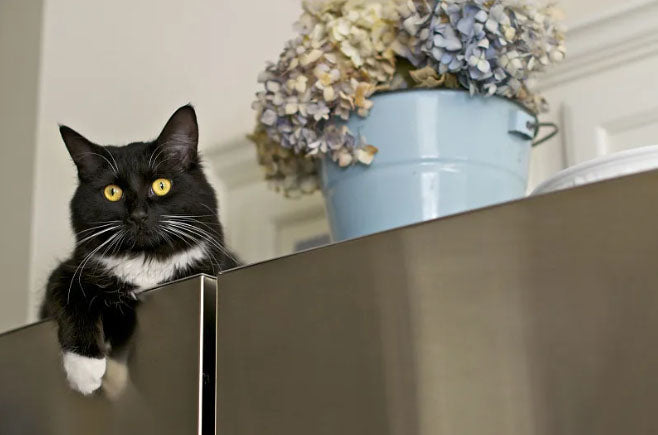- AED
- AFN
- ALL
- AMD
- ANG
- AUD
- AWG
- AZN
- BAM
- BBD
- BDT
- BGN
- BIF
- BND
- BOB
- BSD
- BWP
- BZD
- CAD
- CDF
- CHF
- CNY
- CRC
- CVE
- CZK
- DJF
- DKK
- DOP
- DZD
- EGP
- ETB
- EUR
- FJD
- FKP
- GBP
- GMD
- GNF
- GTQ
- GYD
- HKD
- HNL
- HUF
- IDR
- ILS
- INR
- ISK
- JMD
- JPY
- KES
- KGS
- KHR
- KMF
- KRW
- KYD
- KZT
- LAK
- LBP
- LKR
- MAD
- MDL
- MKD
- MMK
- MNT
- MOP
- MUR
- MVR
- MWK
- MYR
- NGN
- NIO
- NPR
- NZD
- PEN
- PGK
- PHP
- PKR
- PLN
- PYG
- QAR
- RON
- RSD
- RWF
- SAR
- SBD
- SEK
- SGD
- SHP
- SLL
- STD
- THB
- TJS
- TOP
- TTD
- TWD
- TZS
- UAH
- UGX
- USD
- UYU
- UZS
- VND
- VUV
- WST
- XAF
- XCD
- XOF
- XPF
- YER
Why Do Cats Like High Places?

Have you ever searched for your cat in your house, only to spot them watching your every move from high places like the fridge or bookshelf? Just like when we got lost in the supermarket as children, our parents hid behind the shelves to see what we would do.

One of the remarkable skills of cats is how they can find endless new spaces to occupy. They are excellent at planning routes in vertical space, and their claws have a strong grip that helps them access places you might not even realize they can reach.
Why do cats like to hang out in high places?
Predator Avoidance
Animals have an instinct to avoid predators. In the wild, cats may face threats from wolves, eagles, wild dogs, foxes, and pythons. To stay safe, cats choose to occupy higher places, which helps them predict danger and escape quickly. This reduces or eliminates the threat and increases their sense of security.

Observe
Cats are prey to larger animals, but they also hunt smaller animals like squirrels, birds, and rabbits. In their natural habitat, cats like to climb to high places, such as trees and rooftops, to have a better view of their surroundings and to wait for prey.

Prefer Warm Places
Cats prefer to stay in a warm place. They can often be seen lounging in the sun on rooftops or windowsills, enjoying the sunshine. Inside homes, cats like to climb on top of appliances, such as televisions, refrigerators, and microwaves, because these surfaces dissipate heat and provide a comfortable and warm spot for them.
Parade His Skills
How do cats climb to high places and then get back down? This is the perfect opportunity for them to show off their natural abilities.
With sharp, curved claws, small bodies, flexible and powerful limbs, cats are talented in climbing and jumping. Their spine and bones can bend and stretch freely, allowing them to grip objects and climb with ease. When it comes to jumping, cats have powerful limbs that can produce explosive power and thrust. They adjust their body posture and tail position to maintain balance and use their strong muscles and joints for agile movements. To land safely, their flesh pads extend to reduce the impact. Climbing and jumping are also beneficial to the cat's growth and development, enhancing its flexibility and balance.

Explore More Fun at Home with Pet Perches
To prevent damage or harm to your cat, it's important to create safe spaces for them to explore. A common issue is when a cat climbs on an appliance and then accidentally knocks it over and then gets frightened by the loud noise. Instead of letting this happen, give your furry baby new space to explore these habitats.

An effective solution is to add a window perch to their favorite spot. This provides a comfortable place for your furry friend to lounge and enjoy the view. However, be sure to keep your windows closed and secure so your cat doesn't accidentally escape.
Consider DIY some climbing spots on your wall. When mounting cat perches, try varying the spaces between them to challenge your cat to jump or climb from bed to bed.

If you're worried about damaging your walls, consider a window sill cat bed that can hang from your window sill and avoiding to put holes in the wall or taking up too much floor space.


It's important to avoid using ropes or cords at high places as these can pose a danger to your cat. If your cat becomes trapped, it may panic and injure itself trying to escape, which could lead to suffocation or death.

No comments






0 comments